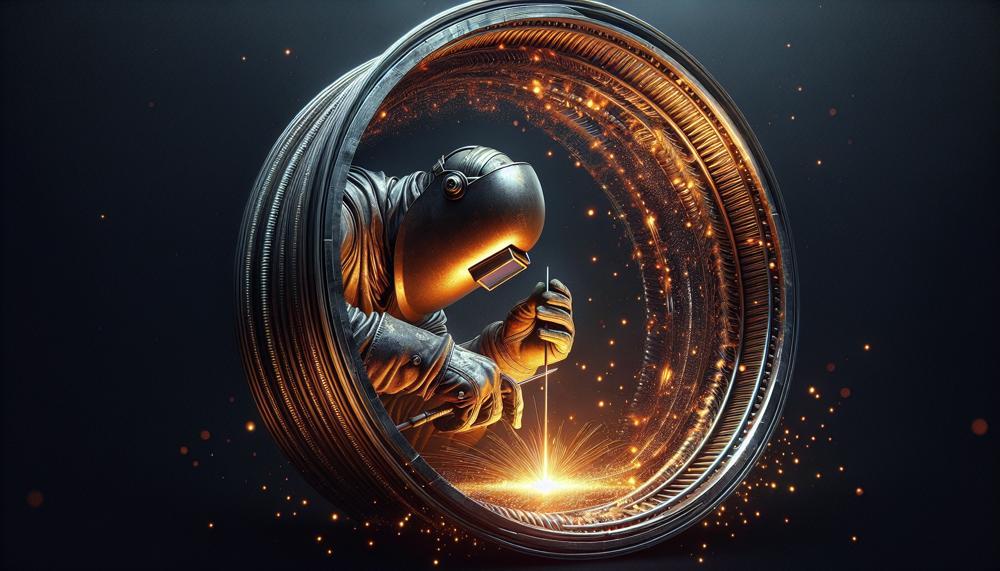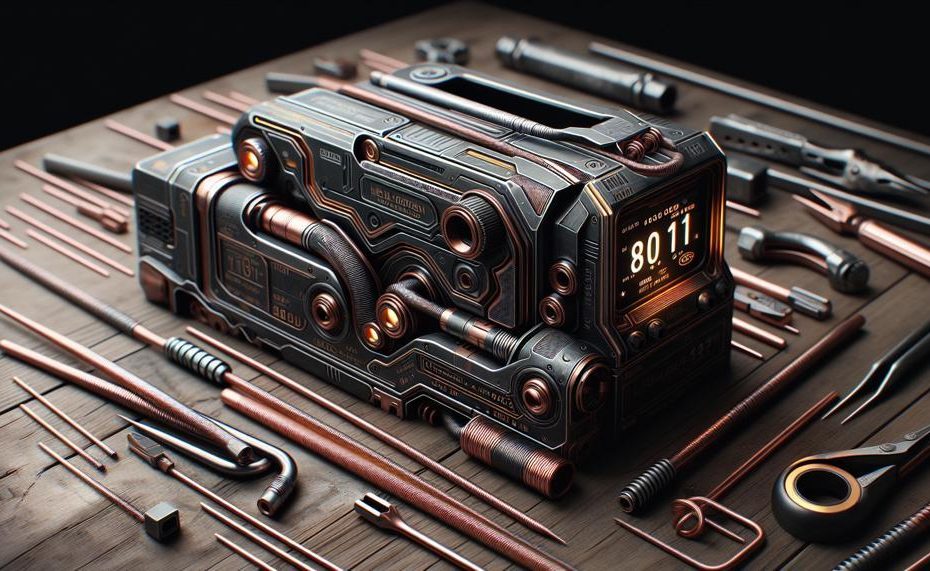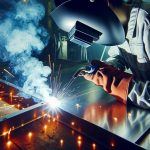Whether you’re a seasoned pro or just starting out, this versatile rod is a must-have in your welding arsenal. With its unparalleled durability and versatility, the 8011 welding rod has become a staple in various industries and applications.
So put on your safety gear and join us as we discover all the incredible potential of the 8011 welding rod.
Contents
8018 Welding Rod
The E8018 welding rod is an incredibly versatile and effective tool that is widely used in various welding applications, especially in high-strength and low alloy steels.
Its exceptional composition plays a significant role in its effectiveness, providing strong and reliable welds while preventing common issues like hydrogen-induced cracking.
The 8018 welding rod has many applications, including:
- Welding High-Strength, Low-Alloy Steels: This welding rod is specifically designed for welding high-strength, low-alloy steels that are commonly used in critical components such as pressure vessels, heavy equipment, and high-tensile pipes. Its impressive strength and compatibility with low temperatures make it ideal for these demanding applications.
- Structural Welding: The 8018 rod is widely used in structural projects such as building construction, bridge fabrication, and repairing heavy equipment. It offers impressive tensile strength, ductility, and impact resistance, making it an excellent choice for structural welds.
- Refurbishing Old or Damaged Equipment: The E8018 welding rod has proven to be highly effective in refurbishing old or damaged equipment due to its ability to produce strong and reliable welds that can withstand high temperatures and pressures.
The unique composition of the E8018 welding rod contributes to its effectiveness in these applications. Its iron powder content increases deposition rate and provides a smooth and steady arc while also preventing hydrogen-induced cracking.
This is particularly crucial when working with high-strength, low-alloy steels that are prone to cracking due to their chemical composition.
Moreover, the low-hydrogen coating of the rod eliminates moisture and hydrogen from the electrode, ensuring top-quality welds without any defects. This is especially critical for critical applications like pressure vessels, where any flaws can result in catastrophic failures.
E8018 Electrode Specification
The E8018 electrode specification is a type of welding rod that is highly effective due to its iron powder composition and low-hydrogen content. It is widely used in various applications, including structural projects, equipment refurbishment, and welding critical components in industries such as aerospace and automotive.
For structural projects, the E8018 electrode is an ideal choice due to its high strength and ability to create sound welds. This makes it suitable for welding joints in bridges, buildings, and other structures. Additionally, it is commonly used in equipment refurbishment as it can produce strong and durable welds that extend the lifespan of old equipment.
In critical industries like aerospace and automotive, the E8018 electrode is a preferred choice for welding components due to its high strength and crack resistibility. It can create welds with good crack resistibility, making them less prone to cracking under stress. Furthermore, the welds are X-ray sound, ensuring no hidden defects or weaknesses.
One of the main characteristics of the E8018 electrode is its low-hydrogen composition. This prevents hydrogen-induced cracking that could weaken the weld and compromise its integrity. Additionally, the addition of iron powder enhances the weld’s mechanical properties, such as impact toughness and tensile strength.
Moreover, the E8018 electrode is highly versatile as it can be used in all welding positions, including horizontal, flat, vertical, and overhead positions. This makes it a valuable tool for welders who need to work in various positions.
8018 Welding Rod Types
There are several varieties of 8018 welding rods, each boasting its own distinct features and preferred uses. These variations differ in their chemical composition, electrode coating, and recommended applications.
- E8018-C1: This type of 8018 welding rod is specifically designed for welding high-strength, low-alloy steels such as ASTM A217, A352, and A38It possesses a low hydrogen coating and contains iron powder to increase the deposition rate and enhance penetration. It is commonly used in heavy structural welding applications, including pressure vessels and large equipment.
- E8018-B2: The E8018-B2 welding rod is ideal for joining chrome-molybdenum steel in various positions. The “B” in its classification indicates its high tensile strength, making it suitable for critical joints and structures. It also has a low hydrogen content and contains iron powder for improved arc stability and deposition rate.
- E8018-D1: The E8018-D1 welding rod is specifically designed for welding high-strength, low-alloy steels in vertical and overhead positions. It possesses a low hydrogen coating that delivers excellent penetration and prevents cracking. Its unique composition also makes it suitable for welding heat-treated steels.
- E8018-G: This type of 8018 welding rod is specially formulated for welding weathering steels or any steel with a high sulfide or sulfur content. It features a special iron powder coating that provides superior strength and toughness compared to other 8018 variants.
- E8018-B6: The E8018-B6 welding rod boasts high tensile strength and is specially crafted for welding chrome-molybdenum steel in all positions. Its low hydrogen coating ensures dependable welds without the risk of hydrogen-induced cracking.
8018 Welding Rod Chemical Composition
The 8018 welding rod chemical composition boasts a balanced blend of iron powder, rutile, and trace amounts of carbon, manganese, silicon, and sulfur. These key components work together to deliver the necessary strength, ductility, and weldability for a wide range of welding tasks.
The iron powder coating on these welding rods is a crucial factor in its popularity. It facilitates a high deposition rate, making it ideal for welding thick materials and handling large welds.
Additionally, it helps prevent hydrogen-induced cracking, a common issue when working with high-strength steels. Furthermore, the iron powder coating creates a smoother and more stable arc, resulting in precise and clean welds.

Another significant ingredient in 8018 welding rods is rutile. This mineral acts as a flux during the welding process, effectively removing impurities from the weld area. As a result, it ensures a strong and durable bond between the metals being welded.
The low levels of carbon, manganese, silicon, and sulfur found in these rods also contribute to their overall strength and ability to withstand low temperatures. This makes them suitable for welding high-strength, low alloy steels in various positions without compromising the weld’s quality.
8018 Welding Rod Meaning
The 8018 welding rod, also known as E8018, is a type of low hydrogen electrode that is widely used in welding processes to join high-strength, low alloy steels. This versatile tool has exceptional properties that make it a go-to choice for demanding applications such as manufacturing pressure vessels, heavy equipment, and high-tensile pipes.
One of the key advantages of the 8018 welding rod is its ability to produce a strong and ductile weld with excellent tensile strength. This makes it a reliable option for critical welds that require high strength and durability. Additionally, its low temperature compatibility and versatility in various welding positions make it a popular choice among welding professionals.
The 8018 welding rod is coated with iron powder, which serves two important purposes. Firstly, it increases the deposition rate, making it easier to work with thicker materials or difficult positions. Secondly, the coating acts as a shield against hydrogen-induced cracking, ensuring that the weld remains strong and reliable.
Another notable advantage of the 8018 welding rod is its compatibility with both alternating current (AC) and direct current electrode positive (DC+). While DC+ is preferred for its stable arc and deep penetration, AC can be useful in preventing arc blow when working with magnetic materials.
To achieve optimal results with the 8018 welding rod, proper handling and set up are crucial. Keeping the electrode dry at all times is essential to avoid hydrogen-induced cracking. Furthermore, choosing the right positioning and angle is vital for achieving precise and strong welds.
8018 Welding Rod Uses
8018 welding rods have become a staple in various industries, including construction, oil and gas, shipbuilding, manufacturing, power generation, railroad maintenance, and structural repair.
These versatile electrodes are ideal for welding heavy structural steel, pipelines, storage tanks, ships, heavy machinery and equipment, and other critical infrastructure projects. Their exceptional strength, resistance to cracks, and ability to be used in any position make them a top choice for demanding welding tasks.
In the construction industry, 8018 welding rods are widely used due to their high strength and durability. From building skyscrapers to constructing bridges, these electrodes are essential in creating strong and stable structures.
In the oil and gas sector, these rods are crucial for welding pipelines that transport oil and gas across long distances. The same goes for the shipbuilding industry, where 8018 rods are used to create sturdy ships that can withstand harsh ocean conditions.
In addition to these industries, 8018 welding rods also play a significant role in manufacturing plants and power generation facilities. They are used to weld heavy machinery and equipment, ensuring they can withstand heavy loads and harsh working conditions.
In the railroad maintenance sector, these electrodes are essential for repairing tracks and other structures, ensuring the safety and efficiency of train operations.
8018 welding rod amperage
The amperage recommended for using 8018 welding rods can differ depending on the rod’s diameter. Generally, a 1/8 inch rod is best suited for an amperage range of 70-100 amps, with the amperage increasing proportionally to the rod’s diameter. For instance, a 5/32 inch rod may need an amperage between 110 and 160 amps.
To find the exact recommended amperage for your specific welding project, it is best to refer to the manufacturer’s guidelines or seek advice from a welding expert.
Other factors such as joint type, base metal thickness, and welding position can also impact the recommended amperage for using 8018 welding rods.
It is crucial to calibrate your welding machine accurately and adjust the amperage accordingly to ensure optimal results and prevent any potential safety hazards.
| Diameter of Rod | Recommended Amperage |
| 1/8 inch | 70-100 amps |
| 5/32 inch | 110-160 amps |
| 3/16 inch | 160-220 amps |
| 1/4 inch | 220-350 amps |
| 5/16 inch | 350-450 amps |
| 3/8 inch | 450-600 amps |
| 7/16 inch | 600-750 amps |
| 1/2 inch | 750-900 amps |
It is important to keep in mind that these are general guidelines and may differ depending on the specific welding project and equipment used. It is always best to thoroughly read and follow the manufacturer’s guidelines for optimal results.
By using the recommended amperage for 8018 welding rods, you can ensure a robust, stable weld that meets industry standards and safety requirements.
E8018 Rod Welding Positions
The E8018 rod, a versatile and high-quality welding electrode, is recommended for welding low alloy, high-strength steels in various positions. This exceptional rod can be used in all positions – flat, horizontal, vertical, and overhead – with outstanding performance and versatility.
Using the E8018 rod in all positions not only increases flexibility and efficiency but also reduces the need for multiple types of electrodes. Welders can rely on this rod for a wide range of welding tasks, making it a highly efficient and cost-effective option. Moreover, the iron powder low hydrogen coating of the E8018 rod significantly increases the deposition rate and prevents hydrogen-induced cracking, ensuring strong and durable welds.
In addition to its versatility, the E8018 rod is compatible with both alternating current (AC) and direct current electrode positive (DC+). While both AC and DC+ are suitable for use, DC+ is preferred due to its stability and control. However, when dealing with magnetic materials, AC is more effective in preventing arc blow.
To achieve optimal results with the E8018 rod, using proper techniques and procedures is crucial. This includes keeping the rods dry and taking time to set up correctly with proper positioning and angle for a sturdy and neat weld.
| Welding Positions | Benefits |
| Flat | The flat position allows for easy manipulation of the rod, providing precise control over welds. |
| Horizontal | Suitable for welding in tight spaces or on vertical surfaces. |
| Vertical | The vertical position provides good penetration and helps prevent slag from falling into the weld pool, ensuring the quality of the weld. |
| Overhead | The overhead position can be challenging but necessary for welding overhead structures. The E8018 rod offers stability and control for smooth welds in this position. |
To achieve optimal results with the E8018 rod, it is important to follow proper techniques and procedures. These include keeping the rods dry and taking the time to set up correctly, with proper positioning and angle for a sturdy and neat weld.
By following these guidelines and using the E8018 rod in recommended welding positions, welders can ensure high-quality results and improve their overall welding efficiency.
7018 vs 8018 Welding Rod
The distinction between 7018 and 8018 welding rods is primarily seen in their composition and tensile strength. While 7018 is an all-purpose low hydrogen electrode, 8018 is a high tensile strength low hydrogen electrode.
The higher tensile strength of 8018 makes it suitable for welding high-strength steels, while the versatility of 7018 makes it ideal for general welding purposes.
Choosing the right welding rod for a project can greatly impact the quality of the weld, as each rod offers different levels of crack resistance and strength.
By understanding these differences, welders can ensure strong and durable welds that meet the specific requirements of each project.
| Welding Rod | Composition | Tensile Strength | Applications |
| 7018 | All-purpose low hydrogen electrode | 70,000 psi | General welding purposes (construction, shipbuilding, manufacturing) |
| 8018 | High tensile strength low hydrogen electrode | 80,000 psi | High-strength welding jobs (military equipment, pressure vessels, heavy machinery) |
While both rods have low hydrogen coatings to reduce cracking, 8018 has superior crack resistance due to its higher tensile strength. This makes 8018 more suitable for welding critical joints or structures that require greater strength.
On the other hand, 7018 is more versatile and commonly used for various applications due to its ease of use and compatibility with different positions.
Also Read: How Much Does A Lincoln Vantage 300 Weight?
Conclusion
In conclusion, the 8011 welding rod is a versatile and indispensable tool that has made its mark in various industries.
Its exceptional strength, durability, and compatibility with different welding positions have solidified its position as a must-have for welders of all levels. Whether you’re tackling critical components like pressure vessels or performing repairs on old equipment, the 8011 welding rod consistently delivers reliable and high-quality welds.
With its widespread use in construction, oil and gas, shipbuilding, manufacturing, power generation, and more, the 8011 welding rod opens up endless opportunities for welders around the world.





